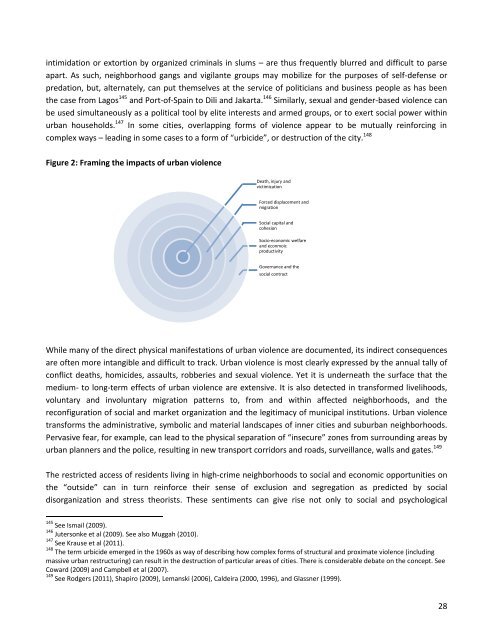Researching-the-Urban-Dilemma-Baseline-study
Researching-the-Urban-Dilemma-Baseline-study
Researching-the-Urban-Dilemma-Baseline-study
You also want an ePaper? Increase the reach of your titles
YUMPU automatically turns print PDFs into web optimized ePapers that Google loves.
intimidation or extortion by organized criminals in slums – are thus frequently blurred and difficult to parse<br />
apart. As such, neighborhood gangs and vigilante groups may mobilize for <strong>the</strong> purposes of self-defense or<br />
predation, but, alternately, can put <strong>the</strong>mselves at <strong>the</strong> service of politicians and business people as has been<br />
<strong>the</strong> case from Lagos 145 and Port-of-Spain to Dili and Jakarta. 146 Similarly, sexual and gender-based violence can<br />
be used simultaneously as a political tool by elite interests and armed groups, or to exert social power within<br />
urban households. 147 In some cities, overlapping forms of violence appear to be mutually reinforcing in<br />
complex ways – leading in some cases to a form of “urbicide”, or destruction of <strong>the</strong> city. 148<br />
Figure 2: Framing <strong>the</strong> impacts of urban violence<br />
Death, injury and<br />
victimization<br />
Forced displacement and<br />
migration<br />
Social capital and<br />
cohesion<br />
Socio-economic welfare<br />
and econmoic<br />
productivity<br />
Governance and <strong>the</strong><br />
social contract<br />
While many of <strong>the</strong> direct physical manifestations of urban violence are documented, its indirect consequences<br />
are often more intangible and difficult to track. <strong>Urban</strong> violence is most clearly expressed by <strong>the</strong> annual tally of<br />
conflict deaths, homicides, assaults, robberies and sexual violence. Yet it is underneath <strong>the</strong> surface that <strong>the</strong><br />
medium- to long-term effects of urban violence are extensive. It is also detected in transformed livelihoods,<br />
voluntary and involuntary migration patterns to, from and within affected neighborhoods, and <strong>the</strong><br />
reconfiguration of social and market organization and <strong>the</strong> legitimacy of municipal institutions. <strong>Urban</strong> violence<br />
transforms <strong>the</strong> administrative, symbolic and material landscapes of inner cities and suburban neighborhoods.<br />
Pervasive fear, for example, can lead to <strong>the</strong> physical separation of “insecure” zones from surrounding areas by<br />
urban planners and <strong>the</strong> police, resulting in new transport corridors and roads, surveillance, walls and gates. 149<br />
The restricted access of residents living in high-crime neighborhoods to social and economic opportunities on<br />
<strong>the</strong> “outside” can in turn reinforce <strong>the</strong>ir sense of exclusion and segregation as predicted by social<br />
disorganization and stress <strong>the</strong>orists. These sentiments can give rise not only to social and psychological<br />
145 See Ismail (2009).<br />
146 Jutersonke et al (2009). See also Muggah (2010).<br />
147 See Krause et al (2011).<br />
148 The term urbicide emerged in <strong>the</strong> 1960s as way of describing how complex forms of structural and proximate violence (including<br />
massive urban restructuring) can result in <strong>the</strong> destruction of particular areas of cities. There is considerable debate on <strong>the</strong> concept. See<br />
Coward (2009) and Campbell et al (2007).<br />
149 See Rodgers (2011), Shapiro (2009), Lemanski (2006), Caldeira (2000, 1996), and Glassner (1999).<br />
28




